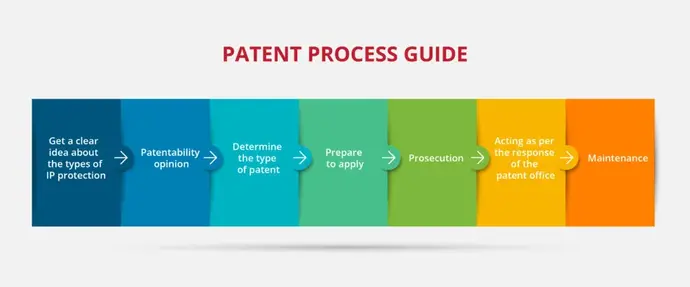Obtaining a patent is a complex and tough process. Here is a patent process guide to breaking down the patent process step by step.

Related article: How to build a perfect patent strategy?
Patent Process Guide: Steps Involved
Step 1
Get a clear idea about the types of IP protection: Patent, copyright, marketing plan, trademark, trade secret are different types of IP protection. Firms examine their needs and use one of these or a combination of these.
Step 2
Patentability opinion: This step involves a prior art search. The main aim is to find if the patent is novel or not. This forms an opinion about the success of the patent. One needs to mention relevant information in patent application hence prior art search becomes essential.
Step 3
Determine the type of patent: According to the patent process guide, After a prior art search, Determine the type of patent you need. There are three types of patent: Design, plant, and utility.
- Design patent: When someone applies to patent a new and unique design for manufacturing purposes.
- Utility patent: This patent covers new processes, products, machines, the composition of matters, or any other new information.
- Plant patent: This patent covers the discovery of new plant species. Scientific experiments on plants also come under this category.
Related article: How to write a patent application accurately?
Step 4
Prepare to apply: The patent process guide suggests that Firms must hire a professional to write the content for the patent. Carefully check the claims in the patent application. Make sure it allows others to use your idea. The cost of obtaining a patent varies from patent to patent
Firms need to wait for a response from USPTO. The time of response is not fixed.
Step 5
Prosecution: Prosecution in terms of patent refers to a communication between the patent office and the patent attorney of the patent owner. The mode of communication is written documents. Also, the main aim of the patent attorney is to convince the patent office to grant a patent.
Step 6
Acting as per the response of the patent office: In case of an incomplete application, the patent office notifies the patent attorney. Firms need to make the changes in a given period, If changes are not made in the given time, the application is dismissed.
Once the changes are made and accepted by the patent office. The patent office forwards the application to examiners.
Examiners then go through the content of the application. Patent attorneys are notified if in case of a mistake. The patent owner needs to rectify the mistakes in a given period.
A patent application is rejected if one doesn’t make changes in a given time. However, Patent owners can question the decision of examiners by filing an appeal with the Patent Trial and Appeal Board (PTAB). In some cases, Examiners reach out to patent attorneys and stakeholders to rectify the issue. In the end, Firms receive official approval from USPTO if they successfully obtain a patent
Step 7
Maintenance: This is the final step of the patent process guide. A maintenance fee is mandatory to maintain a patent for a particular duration. Moreover, maintenance duration ranges from 3 years to 12 years. Also, if one fails to pay the maintenance fee, the patent will expire.
Looking for a patent attorney? – The Patent Drafting Catalyst.
We have a team of best paralegal professionals. Moreover, our services include an end to end IDS management, docketing, documenting drafting, data verification, proofreading. Also, over a decade of experience help us to deliver the best results to achieve customer satisfaction. To avail more of our services, do visit- The Patent Drafting Catalyst.
